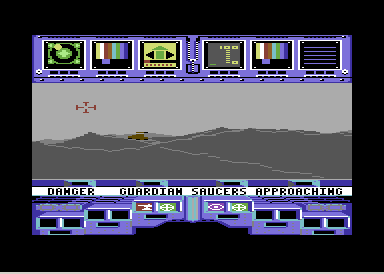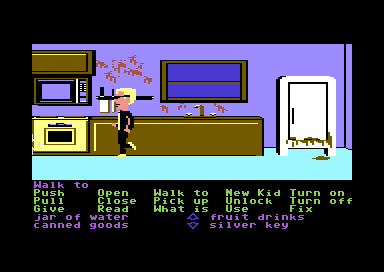Lucasfilm Games
| Lucasfilm Games / LucasArts | ||
|---|---|---|
| Founded | 1982 | |
| Closed | 2013 | |
| Headquarters | Marin County, Californien | |
| Manager | ||
| Employees | 350 | |
| Key People (choice) | Ron Gilbert, Larry Holland, David Fox, Gary Winnick, Peter Langston, David Levine | |
| Turnover | ||
| Sector | Computer and video games | |
| Website | www.lucasarts.com | |
| Information | 2012: Takeover by The Walt Disney Company | |
LucasArts Entertainment Company was a game developer and publisher, founded as Lucasfilm Games in 1982. Before its closure, it was was one of the oldest businesses in the industry, and is mostly famous for its adventure games. While early games were only released for 8-bit home computers, the computer systems Amiga and PC were preferred by the end of the 1980s. By 1993 only PC and state-of-the-art consoles were targeted. The games were distributed by Epyx, Activision and Electronic Arts.
History[edit | edit source]
Lucasfilm Games was founded in 1982, with financial support by Atari after Atari had suggested to George Lucas to develop computer games together. In return, Atari was allowed to develop the first official Star Wars games.
With the help of Atari and the programmers Peter Langston and David Levine, the first games, namely Ballblazer and Rescue on Fractalus!, were developed. Lucasfilm Games almost went bankrupt in 1983. Atari employees had spread pirated copies of the first two games. Since both games offered advanced graphics (Realtime 3D animations with filled surfaces), the copies quickly spread around. In reaction, Atari refused to publish the games. Epyx saw their chance in 1984 and released by games for the Atari 400/800 and the C64. The Eidolon and Koronis Rift followed in 1985.
The fifth game was the first movie-licenced game and was based on the Jim Henson film Labyrinth. This adventure is the direct predecessor of the SCUMM adventures. George Lucas even took the part of the producer in this case.
SCUMM[edit | edit source]
In 1987, Ron Gilbert and Aric Wilmunder developed the revolutionary Script Creation Utility for Maniac Mansion, in short: SCUMM. The revolutionary thing about SCUMM was that no text had to be typed in in a parser, as was common with adventures until then. Instead, players would use the joystick or the mouse to select an action and connect it with an object. That way, simple sentences like "use chainsaw with gas" were built, which in return triggered an animated event. The first game with the SCUMM engine was Maniac Mansion. In 1988, a second adventure called Zak McKracken and the Alien Mindbenders was released, which had been developed by David Fox, Matthew Kane and David Spangler. Both games reshaped the adventure genre. Although there had been Point-and-Click adventures before Maniac Mansion, like Murder on the Mississippi, this kind of control only became popular through these two titles from Lucasfilm Games. SCUMM was used for all following Lucasfilm adventures games up until 1997, and was even licensed to other parties.
Flight simulators and mor Adventures[edit | edit source]
In 1988, a flight simulator for Amiga, Atari and PC, called Battlehawks 1942, followed. It was programmed by Larry Holland. A 200 pages long manual was written for the game, in which experts on World War history presented a lot of historical details. One year later, the successor Their Finest Hour: The Battle of Britain was released, which was awarded Best Simulation of 1989.
Two games were released for Steven Spielberg's third Indiana Jones movie. On the one hand was the adventure game Indiana Jones and the Last Crusade, developed by Ron Gilbert, David Fox and Noah Falstein for Amiga, Atari and PC, and on the other hand the homonymous classical platformer for 8-bit home computers and consoles. The adventure Loom for Amiga and PC, where Mark Ferrari had also participated, followed in 1990. The same year, another adventure classic was released with the pirate adventure The Secret of Monkey Island. Also the puzzle game Night Shift, which was only on the market for a short time, came out.
The last title coming out under the lable (or company name resp.) "Lucasfilm Games" was 1991's flight simulation Secret Weapons of the Luftwaffe by Larry Holland.
LucasArts[edit | edit source]
Lucasfilm Games was renamed LucasArts in 1991. After that, the the adventures The Secret of Monkey Island II, Indiana Jones and the Fate of Atlantis, Day of Tentacle, The Secret of Monkey Island III, Sam & Max and The Dig followed. Furthermore, Rebel Assault and Masterblazer were released. Indiana Jones and the Fate of Atlantis came out for C64 and PC as an action game. However, it hardly sold.
In 1993, the groundbreaking game X-Wing was released.
LucasArts' history as a game developer ended in 2013. After the company was sold to Disney by George Lucas, along with Lucasfilm, ILT and the rights to Star Wars (among others) at the end of 2012, the development section of LucasArts was closed by Disney the next spring. All current projects were canceled and most employees were laid off.
C64 Games (extract)[edit | edit source]



- Released by Epyx
- Koronis Rift (Shooter)
- The Eidolon (Fantasy roleplaying game)
- Released by Activision
- Ballblazer (Space soccer game)
- Rescue on Fractalus! (Shooter)
- Labyrinth (Text-Action-Adventure, movie adaption)
- Maniac Mansion (Adventure)
- Released by Electronic Arts
- PHM Pegasus (Military simulation shooter)
- Strike Fleet (Military simulation shooter)
- Released by Lucasfilm/LucasArts
- Zak McKracken and the Alien Mindbenders (Adventure)
- Habitat (Network game, C64 only)
- Night Shift (Puzzle)
- No official C64 version released
- Battlehawks 1942 (Flight simulation)
- Secret of Monkey Island 1-4 (Adventures)
- Indiana Jones 3-4 (Adventures, Part 3 is a movie adaption)
- Loom (Adventure)
- X-Wing (Space Shooter)
- Rebel Assault (Space Shooter)
- Day of the Tentacle (Manic Mansion 2; Adventure)
- Sam & Max - Hit the Road (Adventure)
- The Dig (Adventure)
- Full Throttle (Adventure)
- Imperial Pursuit (Space Shooter, AddOn for X-Wing)
- B-Wing (Space Shooter, AddOn for X-Wing)
- Tie Fighter (Space Shooter)
- Defender of the Empire (Space Shooter, AddOn for Tie Fighter)
- Masterblazer (Space soccer game)
Links[edit | edit source]
| Wikipedia: LucasArts |
- Website of LucasArts
- History of LucasArts Part 1

- LOAD "REALITY",8,1 - Essay about the early proto-filmlike games of Lucasfilm Games at F.LM - Texte zum Film
